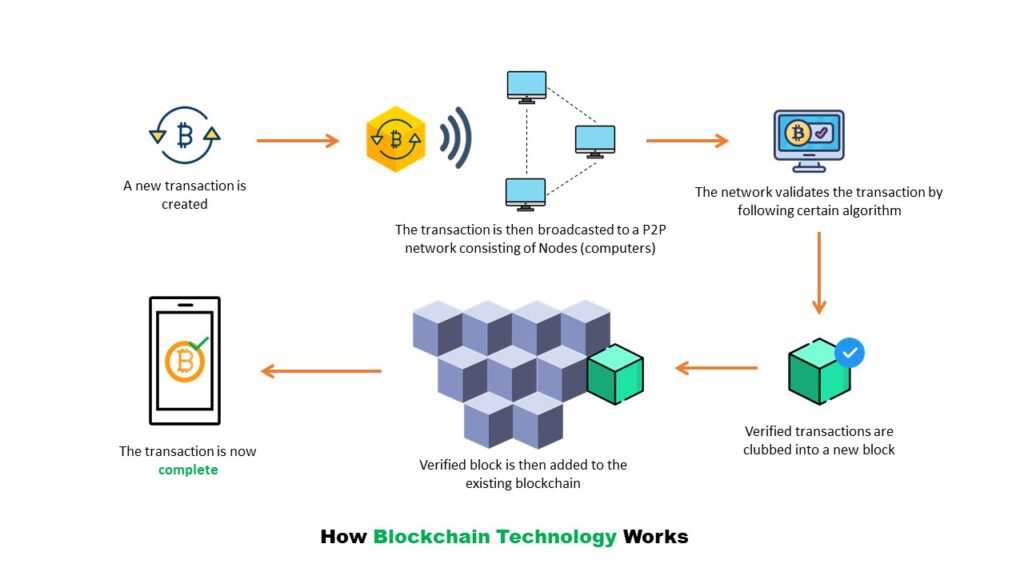

Blockchain Photo by Shubham Dhage on Unsplash
What is Blockchain Technology?
Blockchain technology is a way to store and share information securely and transparently over the internet. Instead of keeping data in a single place or controlled by one entity, a blockchain is a decentralized system where many computers called “nodes” work together to maintain a shared database.
How does Blockchain Technology work?
Let’s break down the functionality in 6 simple steps:
1. Information is recorded in blocks: Imagine a digital ledger where information is stored in blocks. Each block contains a bunch of data, like transactions or records.
2. Blocks are linked together: Once a block is filled with data, it is added to the chain of previous blocks, forming a chain of information. Each block is connected to the one before and after it, creating a chronological order.
3. Multiple computers validate the blocks: Instead of a single entity or organization controlling the blockchain, many computers called nodes work together to validate and verify the information in each block. They make sure the data is accurate and secure.
4. Consensus is reached: Nodes in the blockchain network come to an agreement about the validity of each block. They use special rules and algorithms to ensure that everyone is on the same page and the information is consistent across all the copies of the blockchain.
5. Security through cryptography: Blockchain relies on advanced cryptography to protect the data. Each block has a unique code, called a “hash,” which is like a digital fingerprint. If someone tries to tamper with the information in a block, the hash of that block and all the subsequent blocks would change, alerting the network to the tampering attempt.
6. Decentralization and transparency: Since each node in the blockchain network has a copy of the entire chain, it becomes difficult for any single entity to control or manipulate the information. This decentralized nature makes the blockchain transparent, as anyone can verify the data and ensure its integrity.


What are the key features of Blockchain Technology?
- Decentralization: Blockchain is a decentralized technology, meaning there is no central authority or control. Instead, it operates on a network of computers called nodes, which work together to maintain the system.
- Transparency: Blockchain provides transparency by allowing anyone to view the entire transaction history. This transparency helps to build trust and ensures that all participants have access to the same information.
- Security: Blockchain uses advanced cryptographic techniques to secure transactions and data. Once a transaction is recorded on the blockchain, it is very difficult to alter or tamper with, adding an extra layer of security.
- Immutability: Once information is recorded on the blockchain, it becomes virtually impossible to change or delete. This immutability ensures the integrity and reliability of the data stored on the blockchain.
- Trustworthiness: Blockchain eliminates the need for trust between parties. Transactions are verified and recorded by multiple participants in the network, making it difficult for fraudulent activities to occur without consensus from the majority.
- Efficiency: Blockchain allows for faster and more efficient transactions compared to traditional systems. It eliminates the need for intermediaries, paperwork, and manual processes, reducing costs and speeding up the transfer of assets.
What are the different types of blockchains?
There are primarily three types of blockchains:
- Public Blockchains: Public blockchains are open to anyone and allow anyone to participate in the network as a user or validator.
- Private Blockchains: Private blockchains, as the name suggests, are restricted and accessible only to a specific group of participants.
- Consortium Blockchains: Consortium blockchains are a hybrid between public and private blockchains. They are operated by a consortium or a group of organizations that work together to maintain and validate the blockchain network.
Public Blockchains vs Private Blockchains vs Consortium Blockchains:
| Public Blockchains | Private Blockchains | Consortium Blockchains | |
| Accessibility | Open to anyone who wants to participate. | Restricted and accessible to selected participants. | Shared by a group of organizations or entities. |
| Participation | Anyone can join as a user or validator. | Limited to authorized participants within a specific organization. | Shared participation by multiple organizations or entities. |
| Decentralization | Fully decentralized, with no central authority. | Can be centralized or decentralized depending on the design. | Partially decentralized, shared governance among consortium members. |
| Transparency | Transparent, anyone can view and verify transactions. | Variable transparency, can be less transparent or even confidential depending on the design. | Variable transparency, determined by the consortium’s rules and governance. |
| Control | No single entity has control, decisions made through consensus. | Controlled by a single organization or a consortium of trusted entities. | Shared control and decision-making among consortium members. |
| Examples | Bitcoin, Ethereum, Litecoin. | Hyperledger Fabric, Quorum. | R3 Corda, Hyperledger Sawtooth. |
| Use Cases | Cryptocurrencies, decentralized applications (DApps). | Supply chain management, internal transactions within organizations. | Collaborative industry projects, inter-organizational data sharing. |
How is cryptocurrency based on blockchain?
Blockchain technology is the underlying technology that powers cryptocurrencies. It is the digital ledger or database where all the transactions of a cryptocurrency are recorded. Think of it as a big book that keeps track of who sent and received the cryptocurrency, how much was sent, and when the transactions occurred.
The blockchain ensures the security and transparency of cryptocurrency transactions. When someone makes a transaction using a cryptocurrency, that transaction is recorded as a block in the blockchain. This block is linked to the previous blocks, creating a chain of transactions. This linkage makes it difficult for anyone to alter or tamper with the transaction history.
Additionally, the blockchain is maintained by a network of computers (nodes) that work together to validate and verify the transactions. These nodes use complex algorithms to ensure that the transactions are legitimate and that the same cryptocurrency is not spent multiple times (known as double-spending).
So, in summary, cryptocurrency is a digital form of currency that relies on blockchain technology to secure and record transactions. The blockchain acts as a transparent and decentralized ledger, ensuring the integrity and trustworthiness of the cryptocurrency system.


What is the difference between blockchain and cryptocurrency?
Blockchain: Blockchain is a technology, like a digital ledger or database, that stores and secures information. It is a system that allows multiple computers to work together to maintain a shared and tamper-resistant record of data. The data can be anything, such as transactions, contracts, or even ownership records. Blockchain provides transparency, security, and decentralization by linking blocks of information in chronological order.
Cryptocurrency: Cryptocurrency, on the other hand, is a specific application of blockchain technology. It is a type of digital or virtual currency that uses cryptography for security. Cryptocurrencies, like Bitcoin or Ethereum, are created and managed using blockchain technology. They are designed to be used as a medium of exchange, just like traditional money, but in a digital form. Cryptocurrencies enable secure and direct transactions between individuals without the need for intermediaries, such as banks.
In summary, blockchain is the underlying technology that powers various applications, while cryptocurrency is one of those applications. Blockchain provides a secure and transparent way to store and share information, while cryptocurrency is a digital currency that uses blockchain technology for secure transactions.
Are all cryptocurrencies based on blockchain technology?
No, not all cryptocurrencies are based on blockchain technology.
Cryptocurrencies like Bitcoin, Ethereum, Cosmos, Cardano, Dogecoin, Litecoin, Tether, etc are based on blockchain technology. They use a decentralized and transparent ledger called a blockchain to record and verify transactions.
However, there are some cryptocurrencies like IOTA, Hashgraph, Byteball, Holochain, etc are not based on blockchain. IOTA, for example, is a cryptocurrency designed for the Internet of Things (IoT) ecosystem, It uses a different technology called the Tangle, which is a directed acyclic graph (DAG) structure.
What are some use cases of blockchain technology?
- Cryptocurrencies: Blockchain technology is most commonly associated with cryptocurrencies like Bitcoin and Ethereum. Cryptocurrencies use blockchain as a decentralized and secure platform for transactions, enabling individuals to send and receive digital currency without intermediaries like banks.
- Supply Chain Management: Blockchain can be used to track and verify the movement of goods throughout the supply chain. It provides transparency and immutability, allowing participants to trace the origin, location, and condition of products, ensuring authenticity and reducing fraud.
- Financial Services: Blockchain can revolutionize various financial services, such as cross-border payments, remittances, and smart contracts. By eliminating intermediaries and enabling direct peer-to-peer transactions, blockchain can make financial processes faster, more efficient, and more secure.
- Healthcare: Blockchain can enhance the security, privacy, and interoperability of healthcare data. It allows for the secure sharing of patient records among healthcare providers, reduces medical fraud, and enables better tracking of pharmaceutical supply chains.
- Voting Systems: Blockchain technology can provide a transparent and tamper-resistant platform for conducting secure elections. It can ensure the integrity of votes, prevent fraud, and increase trust in the electoral process.
- Intellectual Property Management: Blockchain can be used to register and protect intellectual property rights, such as copyrights and patents. It provides a timestamped and tamper-proof record of ownership, enabling creators to prove the existence and ownership of their intellectual assets.
- Decentralized Applications (DApps): Blockchain enables the development of decentralized applications that operate on a peer-to-peer network. These DApps can cover various industries like finance, gaming, social media, and more, providing users with increased control, privacy, and security.
- Energy Trading: Blockchain can facilitate peer-to-peer energy trading by enabling direct transactions between energy producers and consumers. It enables the transparent recording of energy generation, consumption, and payments, fostering a more efficient and decentralized energy market.
- Insurance: Blockchain can simplify and automate insurance processes, including claims management, underwriting, and fraud prevention. It increases transparency, reduces costs, and enhances trust between insurers and policyholders.
These are just a few examples, and the potential use cases of blockchain technology continue to expand as more industries explore its capabilities.
What are some key limitations of blockchain?
- Scalability: Blockchain technology faces challenges in handling a large number of transactions quickly. As the network grows, it becomes slower and less efficient, which can limit its scalability for certain applications.
- Energy Consumption: Blockchain networks, particularly those that rely on proof-of-work consensus algorithms like Bitcoin, require significant computational power and energy consumption. This can have negative environmental impacts and make blockchain less energy-efficient compared to traditional systems.
- Storage Requirements: Blockchain networks store a complete copy of the entire transaction history, which can result in substantial storage requirements. As the blockchain grows in size over time, it becomes more resource-intensive to maintain and can pose challenges for nodes with limited storage capacity.
- Governance and Regulatory Challenges: Blockchain technology presents governance and regulatory challenges due to its decentralized nature. Determining responsibility, resolving disputes, and implementing changes to the network can be complex, especially in public blockchains where multiple participants are involved.
- Privacy Concerns: While blockchain offers transparency, it also poses challenges to privacy. Transactions recorded on a blockchain are typically visible to all participants, which may not be desirable for certain applications that require strict privacy or confidentiality.
- Adoption and Interoperability: Blockchain technology is still in its early stages, and widespread adoption can be a challenge. Different blockchain platforms and protocols may not be fully compatible with each other, leading to interoperability issues when attempting to connect or transfer assets between different blockchains.








